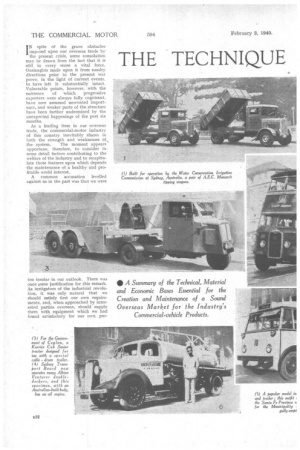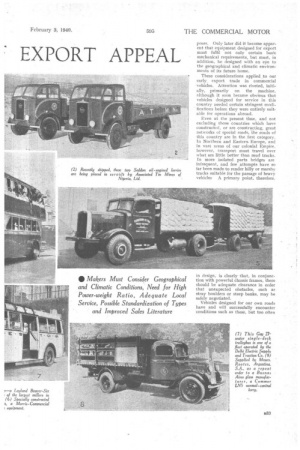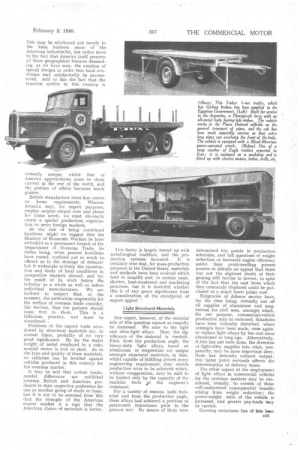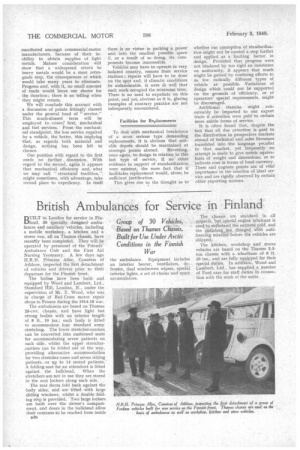THE TECHNIQUE EXPORT APPEAL
Page 52

Page 53

Page 54

Page 55

Page 56

If you've noticed an error in this article please click here to report it so we can fix it.
IN spite of the grave obstacles imposed upon our overseas trade by the present crisis, some consolation may be drawn from the fact that it is still in every sense a vital force. Onslaughts made upon it from sundry directions prior to the present war prove, in the light of current events, to have left it substantially intact. Vulnerable points, however, with the existence of which progressive exporters were always fully cognisant, have now assumed unwonted importance, and weaker parts of the structure have been further undermined by the unexpected happenings of the past six months.
As a leading item in our overseas trade, the commercial-motor industry of this country inevitably shares in both the strength and weaknesses of the system. The moment appears opportune, therefore, to consider in some detail factors contributing to the welfare of the industry and to recapitulate those features upon which depends the maintenance of a healthy and profitable world interest.
A common accusation levelled against us in the past was that we were
too insular in our outlook. There was once some justification for this remark. As instigators of the industrial revolution, it was only natural that we should satisfy first our own requirements, and, when approached by interested parties overseas, should supply them with equipment which we had found satisfactory for our own pur
poses, Only later did it become apparent that equipment designed for export must fulfil not only certain basic mechanical requirements, but must, in addition, be designed with an eye to the geographical and climatic environments of its future home.
These considerations applied to our early export trade in commercial vehicles. Attention was riveted, initially, primarily on the machine, although it soon became obvious that vehicles designed for service in this country needed certain stringent modifications before they were entirely suitable for operations abroad.
Even at the present time, and not excluding those countries which have constructed, or are constructing, great networks of special roads, the roads of this country are in the .first category. Tn Northern and EasternEurope, and in vast areas of our colonial Empire, however, transport must travel over what are little better than mud tracks. To more isolated parts bridges are infrequent, and few attempts have so far been made. to render hilly or marshy tracks suitable for the passage of heavy vehicles A primary point, therefore,
in design, is clearly that, in conjunction with powerful chassis frames, there should be adequate clearance in order that unexpected obstacles, such as stray boulders or steep banks, may he safely negotiated.
Vehicles designed for our own roads have and will successfully encounter conditions such as these, but too often they have perished in the attempt ; it will be no consolation to the operator to be told that elsewhere his vehicle has, indeed, proved a great success. Such a statement is of mere theoretical -interest; the vehicle must be capable of subduing the environment at its disposal.
A further point in the elements of design ia furnished . by the relative length, of .run in this country and abroad. The factor here is not one of absolute distance, hut rather the interval which separates one centre from another.
Nowhere in England is it possible to ,traverse more than 10 or 20 miles without passing through some populated centre, whereas, in the colonies, in Eastern Europe and much of America, distances four or five times as great as these may commonly be covered in passing from one town to its neighbour. Special care must, therefore, be paid to the capacity of fuel tanks, which must be adequate to meet any
contingencies arising as a result of this sparse distribution of populated areas. Considerations of a similar order govern the power units with which commercial motors for operation abroad are provided. The low-power unit has, indeed, its uses for local runs in the neighbourhood of towns, but for inter-urban transport, more powerful units are favoured.
Conceptions of pay-load tend sometimes to be based too closely on the requirements of this country alone. For the export market it is essential that a broader view be taken. Not only must those factors already referred to be reckoned with, but note must also be made of the industrial or agricultural development and organization of the localities to which it is desired to export.
Transport Needs Overseas
The sparse distribution of industrialized areas overseas is frequently load to contrast strangely with the huge size of certain concerns located in them. Often, in fact, an industrial area will virtually consist of one large self-contained concern, the transport facilities required by which may well equal those called for by half a dozen or more similar concerns in this country, where difficulties which might otherwise arise, are often .masked by the simultaneous existence of road and rail facilities. In the areas to which we refer there is no, road-rail war; the dommercial motor holds the field alone and must be prepared, therefore, to
cope with all the responsibilities entailed.
Those aspects of design already noted are of a more or less obvious nature and are generally appreciated. Other factors exist, however, which are less obvious, although, again, dependent primarily on peculiarities of geographical environment.
Particularly for very long runs between isolated communities far removed from seaports and other convenient fuel-storage bases, such as occur, for example, in China and, possibly, in certain parts of Australia, the transport of sufficient fuel alone presents a difficult problem.
It has been pointed out that journeys.' of such a length may be entailed'that,2., were the vehicle loaded to capacity ' with petrol, it could carry hardly
enough to suffice for the run. It is rather surprising,, therefore, that attention was not given at an earlier date to gaseous fuels proVided by suitably designed transportable producers.
The development of ,such devices has, indeed, been forced upon us by the present emergency, but it appears that stronger effort should have been made earlier to evolve a really satisfactory form, for use, say, in tropical countries where wood is plentiful. Expediency rather than efficiency governs the adoption of systems of this type, and instances may, in fact, be quoted where individual initiative has made use of them when the need has arisen.
At this point it is proper to observe that the popularity of American commercial vehicles abroad is largely owing to the fact that, in design, they comply with the basic requirements listed here. This may be attributed not merely to the keen business sense of the American industrialist, but rather more to the fact that America itself presents all those geographical features demanding, as we have seen, the creation of special designs in order that local con. ditions may satisfactorily be encountered. Add to this the fact that the taxation system in this country is virtually unique, whilst that of America approximates more to those current in the rest of the world, and the posture of affairs becomes much plainer.
British manufacture must first centre on home requirements. Whereas America may, for export purposes, employ surplus output over and above her home needs, we must obvioirly create a special production.. organization to serve foreign markets.
At the risk of being considered facetious, might we suggest that the Ministry of Economic Warfare be later embodied as a permanent branch of the Department of Overseas Trade, its duties being, when present hostilities have ceased, confined not so much tooffence as to the strategy of defence? Let it undertake actively the examination and study of local conditions in prospective markets abroad, and lay the result of its work before the industry as a whole as well as before individual manufacturers. We are inclined to suspect that, at the moment, the authorities responsible for the welfare of overseas trade consider, like doctors, that the patients should come first to them. This is a fallacious practice, and must be abandoned., Problems in the export trade occasioned by structural materials are, in normal times, probably of no very great significance. By far the major weight of metal employed in a commercial motor is iron or steel. As to the type and quality of these materials, no criticism can be levelled against vehicles produced in this country for the overseas market.
It may be said that certain fundamental differences are exhibited between British and American producers-in their respective preference for one or another group of steels or irons, but it is not to bo assumed from this that the strength of the American export market is a sign that the American choice of materials is better.
• 'I his factor is largely bound up with metallurgical tradition, and the production systems favoured. It is certainly true that, for mass-production purposes in the United States, materials and methods have been evolved which tend to simplify and, in certain cases, shorten, heat-treatment and machining processes, but it is doubtful whether this is of any grave significance from a consideration of the standpoint of export appeal.'
Light StruCtural Materials
One aspect, however, of the material side of this question cannot so casually be dismissed. We refer to the light and ultra-light alloys. Here, the significance of the material is twofold. First, from the production angle, the:' heavy-duty light alloy*, based on aluminium or magnesium are unique amongst structural materials, in that, whilst capable of fulfilling almost every engineering requirement, they enable production rates to be achieved which, without exaggeration, may be said to be limited only by the capacity of the machine tools s.t the engineer's command.
For a variety of reasons, both technical and from the production angle. these alloys had achieved a position of paramount importance prior to the present war. By means of them were determined key points in production schedules, and (all questions of weight reduction or increased engine efficiency aside) their profit-swelling powers possess so definite an appeal that there was not the slightest doubt of their gaining still further in favour, in spite of the fact that the cast irons which they commonly displaced could be purchased at a much lower prime cost.
Exigencies of defence service have, for the time being, virtually cut off all supplies of aluminium and magnesium for civil uses, amongst which, for our purpose, commercial-vehicle production may be reckoned. Schedules have been violently disturbed where attempts have been made, onoe again, to replace light alloys by the cast irons abandoned so long ago. Alternatively, if.this has not been done, the diversion of light-alloy supplies into what, temporarily, may be more important directions has seriously reduced output ; this latter point seriously affects the determination of delivery times.
The other aspect of the employment of light alloys in commercial vehicles for the overseas markets may be Considered, btoidly, to consist of those well-lunderstOod consequential benefits arising from weight reduction; . the power-weight ratio of the vehicle is increased, and greater pay-loads may be carried.
Growing uneasiness has of late been B35
manifested amongst commercial-motor manufacturers, because of their inability to obtain supplies of light metals. Mature consideration will show that a widespread return to heavy metals would be a most retrograde step, the consequences of which would take many years to eliminate. Progress and, with it, no small amount of trade would leave our shores for the duration; there is no telling when they might return.
We will conclude this account with a discussion of points fittingly classed under the general head of ' service." This much-abused term will be employed to • cover: first, mechanical and fuel services. From the mechanical standpoint, the less service required by a vehicle, the better, this implying that, as regards both material and design, nothing has been left to chance.
Our position with regard to the first needs no further discussion. With regard to the second, again it appears that mechanical efficiency and, what we may call " structural tradition," might sometimes, with advantage, take second place to expediency. In itself there is no virtue in packing a power unit into the smallest possible space if, as a result of so doing, its components become inaccessible.
Vehicles may have to operate in very isolated country, remote from service stations ; repairs will have to be done on the spot and, if climatic conditions be unfavOurable, it were as well that such work occupied the minimum time. There is no need to expatiate on this point, and yet, obvious as it is, glaring examples of contrary practice are not infrequently encountered.
Facilities for Replacements To deal with mechanical breakdown of a more serious type demanding replacements, it is obvious that suitable depots should be maintained at strategic points abroad. Reverting, once again, to design in relation to this last type of service, if no' other evidence in support of standardization were existent, the mere fact that it facilitates replacement would, alone, be sufficient justification.
This gives rise to the thought as to whether our conception of standardization might not be carried a step farther and applied as a limiting factor in design. Provided that progress were not hindered by too rigid an insistence on uniformity, it appears that much might be gained by confining efforts to as few radically different types of vehicle as possible. Variations of design whinh could not be supported on the grounds of efficiency, or of operators' special requirements, might be discouraged.
Additional stamina might conceivably be imparted to our export trade if attention were paid to certain more subtle forms of service.
It is often found that, despite the fact that all due attention is paid to the distribution in prospective markets abroad of technical and sales literature translated into the language peculiar to that market, yet frequently' no attempt is made to give metric equivalents of weight and dimensions, or to indicate cost in terms of local currency. These and cognate points are of vital importance in the creation of ideal service and are rigidly observed by certain other exporting nations.








































































































